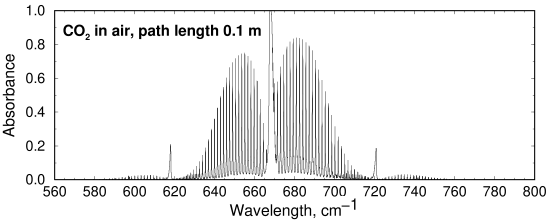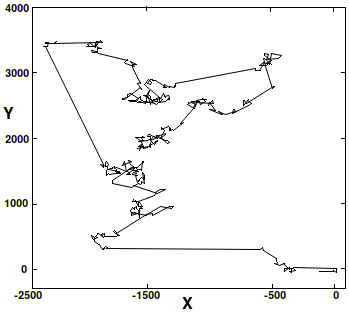 here are
now thousands of papers claiming that global warming is causing
everything from
male infertility to
neurological disorders to
diarrhea to
ADHD and even
anthrax.
One paper predicts that global warming will cause
more deaths than Covid.
Another predicts a
billion human deaths of “mainly poor humans” by “mainly
richer humans” and debates whether to call it murder or manslaughter.
Others claim that global warming exacerbates every fire
and every hurricane and causes every cold day, every hot day, and every
snowstorm. The scientific papers all say the same thing: there's “evidence”
for it. But the missing link is causation. If the only “evidence”
is a computer model, the papers are wrong: a computer model is not and can
never be evidence, even if it's done correctly.
here are
now thousands of papers claiming that global warming is causing
everything from
male infertility to
neurological disorders to
diarrhea to
ADHD and even
anthrax.
One paper predicts that global warming will cause
more deaths than Covid.
Another predicts a
billion human deaths of “mainly poor humans” by “mainly
richer humans” and debates whether to call it murder or manslaughter.
Others claim that global warming exacerbates every fire
and every hurricane and causes every cold day, every hot day, and every
snowstorm. The scientific papers all say the same thing: there's “evidence”
for it. But the missing link is causation. If the only “evidence”
is a computer model, the papers are wrong: a computer model is not and can
never be evidence, even if it's done correctly.
Thermal radiation
In this section we describe the theory. We will use ‘global warming’ instead of ‘climate change’ because ‘climate change’ is not a meaningful term.
The basic theory of global warming is that visible light, UV, and near-infrared radiation coming from the sun are absorbed by the ground, then re-emitted as thermal infrared radiation, both during the day and at night. If re-radiation is blocked, the temperature rises to rebalance the incoming and outgoing energy, which must be equal.

Fig 1 Global warming has harmful effects on plants, causing widespread ice damage due to the freezing cold. The fact that this makes zero sense is why it was renamed
You can think of infrared radiation as being in two types. There's near-infrared, which makes up about half of the radiation we get from the Sun; and thermal infrared, which is longer wavelengths, which we feel as heat. About half of the radiation we receive from the Sun is in the visible and half is near-infrared, or near-IR. There is also a much smaller amount of ultraviolet and thermal infrared. When visible, UV, or near-IR gets absorbed on your face or the ground it turns into heat, which can then be re-radiated. So, if there are gases that absorb radiation, you might think: Aha! Those gases get warmer, so the earth stays warmer. Unfortunately, that's not how gases work.
You can see the different types of infrared radiation yourself. Snow doesn't absorb visible or near-IR light, but it strongly absorbs thermal infrared. On a sunny day, the visible and near-IR light are either reflected or transmitted, which means they pass right through the snow and get absorbed by the ground. At that point it's re-emitted as thermal IR. This is why the snow underneath is warmer than the snow on the surface and why it always melts from below rather than from the top.
Absorption vs scattering
Absorption is logarithmically dependent on concentration, so each time CO2 doubles it theoretically raises the temperature by the same amount. Its main effect is to shorten the free path length of IR photons, which is the distance a photon travels after it's emitted before it gets scattered or absorbed.

Fig. 2 High resolution absorbance spectrum of a sample of carbon dioxide in air. The wings on both sides are vibration modes and much weaker than the main line (Source: Hitran)
Physicists tell us that absorption and scattering are physically the same. The only difference is what happens to the energy after it gets absorbed. In scattering, the photon is emitted at a wavelength close to the original wavelength. In absorption, the photon is usually converted to mechanical vibration, where the molecules transfer their energy to each other by colliding with each other. There is always thermal energy getting emitted and re-absorbed. When there's a temperature gradient, this causes radiative or conductive energy transfer from the warmer molecule to the colder one.
People sometimes think that light absorption and emission occur in wide bands. This is not so: in gases, photons are emitted in very narrow bands (Fig. 2). The bands, called transition lines, are extremely narrow but not infinitely narrow due to Doppler and other effects. They're slightly wider at the Earth's surface due to pressure broadening, but still quite narrow. Older spectrometers didn't have the resolution needed to show the bands accurately.
This has important consequences for a photon's path length. Fig. 3 shows the path a photon takes during scattering. When it scatters, its wavelength can be anywhere within the narrow emission line. This is called CFR or complete frequency redistribution. If it stays near the center of the line, it's quickly reabsorbed by another molecule. If it happens to be near the edge of the line, its path length can be 10,000 times greater. So the path doesn't resemble a random walk but contains a mixture of short and long jumps. This is called Lévy flight.
This contrasts with thermal radiation from the ground, which is emitted in a broad continuum. Only a small part of that radiation is within the narrow CO2 absorption line, so the effect of CO2 is rapidly maxed out.

Fig. 3 Photon scattering with CFR and Lévy flight. A photon in a gas doesn't follow a random walk path, but a complicated path with short and long jumps as it gets absorbed and re-emitted by scattering (Redrawn from [2], p. 16)
Entire books have been written on this interesting subject, which is called radiative transfer. They're stuffed with math formulas and technical details. If you're interested I recommend Fundamentals of Atmospheric Radiation: An Introduction With 400 Problems by Craig F. Bohren and Eugene E. Clothiaux.[1] Believe it or not, this book is highly entertaining—and not just because of the 400 math problems!
Those who say the current level of 0.04% is too low to have any effect are mistaken. In fact, at 0.04% absorption by CO2 is fully saturated, which means in simple terms that we're way in the horizontal phase of the logarithmic curve, which means we've got as much warming from CO2 as we're ever going to get. Climate alarmists know this as well. This may be why they've started talking about methane and CFCs. They'll never admit that to the politicians because it would destroy their credibility to say they were wrong about CO2 and it was methane or CFCs all along.
If you think warming is a problem you will have painted your roof white instead of black to reflect the visible and UV light back to space. Didn't do it? That means at some level the theory didn't convince even you.
Computer models
Given this complexity, you might think a computer model could sort it all out and tell us if there's a problem or not. Unfortunately, this is not true. A computer model can tell you if your theory is false, but it can never tell you if something is true. It certainly can't tell you whether something exists.
A computer model takes all the relationships in your theory, multiplies them by their relative importance, and spits out the answer. If the answer disagrees with measurements it proves your theory is wrong. Period. If it agrees with measurements it only means it's consistent with them, but that could just be a coincidence.
I've been doing pharmacokinetic models and molecular docking models for much of my career. It often happens that a model gives the wrong answer. This is the only time you learn anything, namely that you don't understand everything that's going on. “Tuning” those models to make the results what I thought they should be would have made them useless.
Yes, you can estimate half-life and elimination rates from a PK/PD model. You can estimate reaction rates and affinities in enzyme kinetic models. This is not modeling in a meaningful sense. It is curve fitting because it calculates some parameter to fit existing data. A predictive model, such as those used in particle physics, calculates expected results from a theory and must be tested experimentally. Predictive models are often wrong, sometimes wildly wrong. As usual, physics holds the record.
Tuning is a fundamental misunderstanding of the purpose of a model, which is to test your theory and see if the result matches what you observed. The goal isn't to have a computer model; the goal is to see if your theory is correct. If it doesn't match, your theory is wrong, period. If you tweak the model to give it the desired result you learn nothing at all.
That's exactly what is happening with those climate models. They predict the wrong result for the current state—this is a well known problem—and the models give the wrong result for the historical data by a large factor. So they're “tuned” to give the correct result for historical data. This is a scientifically invalid approach. The model proved the theory was wrong and they changed the parameters to make the model give the answer they wanted.
Why is this invalid? That correction factor, or fudge factor, or whatever you want to call it, has no theoretical or experimental basis. The model is no longer a model, but a program that gives the correct answer because you told it the correct answer and tweaked it until it gave it to you. It succeeds only in confirming that our understanding of climate is still inadequate to make accurate predictions. If warming should turn out to be a real problem, assigning the wrong cause would prevent us from finding a solution.
Predictions
Even if a computer model is on shaky ground it could have some value if it generates predictions that are subsequently verified. Unfortunately, most of the changes, including changes in weather patterns, rising sea levels, ecological changes and tropical diseases, if they occur, would be consequences of temperature alone and thus say nothing about the theory. Other changes such as ocean acidification are related to CO2, not temperature. Thus, even if they occurred they would say nothing about the CO2 hypothesis, which is that there is a causal connection between CO2 and temperature.
The question is not whether it's possible for CO2 to cause warming; the question is whether it's a trivial amount or a potential crisis. The fact is, the only connection between temperature and CO2 is a computer model. Even if the model was correct, the most a computer model can ever do is to prove the theory is wrong. Not only is the science not “settled”; as far as the CO2 hypothesis is concerned there's no science there at all.
[1] Fundamentals of Atmospheric Radiation by Craig F. Bohren and Eugene E. Clothiaux
jan 18 2025, 4:06 am. edited for brevity jan 23. Original version last updated jan 26 2025
